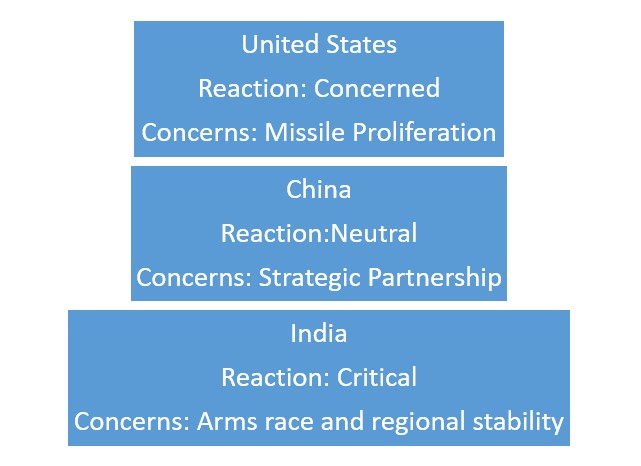The Shaheen-II, also known as Hatf-VI is a medium-range ballistic missile currently in deployed in military service with the strategic command of the Pakistan Army. The Pakistani military refers to Shaheen-II, a nuclear weapons-delivery missile that was designed and developed by the National Engineering & Scientific Commission.
Shaheen-II Missile is capable of carrying both conventional and nuclear warheads up to a range of 1,500 kilometers. Shaheen-II is a highly capable missile that meets Pakistan’s strategic needs towards the maintenance of desired deterrence stability in the region.
Since 2000, the United States had prior knowledge of such a program and was able to confirm it in 2005, when a six-axled-ten-wheel MAZ vehicle was shown in the military barracks.
Shaheen-II is seen by Indian defense observers as the “backbone of Pakistan’s survivability with ground-based second strike capability.
Understanding the Origins of Pakistan’s Missile Program
Imagine a time after the 1971 war when Pakistan’s leadership realized that to safely measure national security, it needed more than just conventional military strength.
The idea of a strong missile deterrent started to take shape. This realization set Pakistan on a path toward developing its own missile capabilities.
The Beginnings:
-
- Post-1971: Pakistan recognized the need for a strong preventive.
- Initial Steps: Early collaborations and the first native efforts to develop missile technology.
The Evolution of Shaheen-II
Pakistan was prepared to launch the Shaheen-II, a missile that would later become the core of its defense policy, by the late 1990s.
Pakistan needed a dependable long-range missile because tensions in the area were rising, and Shaheen-II was created to fulfill that demand.

Technical Specifications of Shaheen-II
Let’s talk specs!
The Shaheen-II is a driving force of technology designed to deliver payloads with precision.
Range and Payload
-
- Range: 2,500 kilometers (1,550 miles).
- Payload Capacity: Up to 1,000 kg.
- Warhead Options: Both nuclear and conventional.
Propulsion and Guidance
-
- Propulsion: Solid-fuel, two-stage rocket motor.
- Guidance System: Advanced inertial guidance with a CEP (Circular Error Probable) of less than 250 meters.
Launch Capabilities
Shaheen-II’s launch system is designed for mobility and rapid deployment, crucial features in a high-stakes scenario.
| Feature | Description |
| Launch Platform | Mobile Transporter Erector Launcher (TEL) |
| Mobility | High, allowing for strategic positioning and survivability |
Why Does Shaheen-II Matter?
In the world of geopolitics and defense, it’s a game-changer for Pakistan. Here’s why:
Deterrence Factor
-
- The core of Minimum Credible Deterrence: Ensures Pakistan can effectively counter any regional threats.
- Balance of Power: Acts as a counterbalance to the missile developments of neighboring countries.
Role in the Nuclear Harmony
-
- Complements Other Forces: Ensures a second-strike capability alongside air and sea-based nuclear forces.
- Strategic Depth: Enhances Pakistan’s ability to respond effectively to any aggression.
Shaheen-II is actively integrated into Pakistan’s defense strategy and is regularly tested in military exercises.
First Test Launch
Back in 2004, Pakistan conducted the first successful test of Shaheen-II.
It was a critical moment, signaling to the world that Pakistan had significantly advanced its missile technology.
The Test
| Date | Outcome |
| March 9, 2004. | Successfully hit the designated target with precision.
|
Subsequent Tests and Refinements
Since then, Shaheen-II has undergone numerous tests to refine its technology and ensure its readiness.
Ongoing Tests:
-
- Multiple Launches: Each test is aimed at improving accuracy and reliability.
- Last Known Test: November 13, 2014.
Deployment and Readiness
Today, Shaheen-II is fully integrated into Pakistan’s Strategic Plans Division (SPD) and deployed in strategically vital locations.
| Deployment Areas | Strategic Importance |
| Northern Pakistan | Defensive depth against regional threats |
| Southern Regions | Coverage of important military and economic targets |
What are the Regional and Global Implications of Shaheen-II
Impact on South Asia
The introduction of Shaheen-II has had a profound effect on the strategic balance in South Asia. It’s a key part of Pakistan’s deterrent against potential adversaries, particularly India.
Maintaining Balance:
-
- Equilibrium with India: Helps maintain a stable balance of power in the region.
- Preventing Escalation: Serves as a strong deterrent against regional conflicts.
Global Reactions
Internationally, Shaheen-II has drawn mixed reactions, with some countries expressing concern over the potential arms race in South Asia.

By the Numbers
| Statistic | Value |
| Operational Units | Estimated 10-15 (approximate, classified) |
| Annual Defense Budget Allocation | 15-20% towards missile development |
| Comparative Range | 2,500 km (Shaheen-II) vs. 3,500 km (Agni-II) |
Comparative Analysis with Regional Missiles
When you compare Shaheen-II with India’s Agni-II, it’s clear that Pakistan has developed a challenging deterrent.
| Feature | Shaheen-II | Agni-II |
| Range | 2,500 km | 3,500 km |
| Payload | 1,000 kg | 1,000 kg |
| Accuracy (CEP) | < 250 meters | ~ 100 meters |
What’s Next for Shaheen-II?
As technology evolves, so does the potential for upgrades to the Shaheen-II. Pakistan is actively working on enhancing this missile’s capabilities, with an eye towards maintaining its edge.
Upgrades and Modernization
-
- Extended Range: Potential for increasing the missile’s range beyond 2,500 km.
- Accuracy Improvements: Ongoing work to refine guidance systems further.
Pakistan is also exploring new missile technologies, such as the development of Shaheen-III, which could extend its reach even further and incorporate multi-warhead capabilities.
| Future Development | Focus |
| Shaheen-III | Extended range, multi-warhead capability |
| C4I Systems Integration | Enhanced command and control capabilities |
Conclusion
Shaheen-II ballistic missile is another weapon in Pakistan’s resources.
it’s a cornerstone of the country’s defense strategy. As we’ve seen, its development and deployment have had profound implications not just for Pakistan, but for the entire region.



